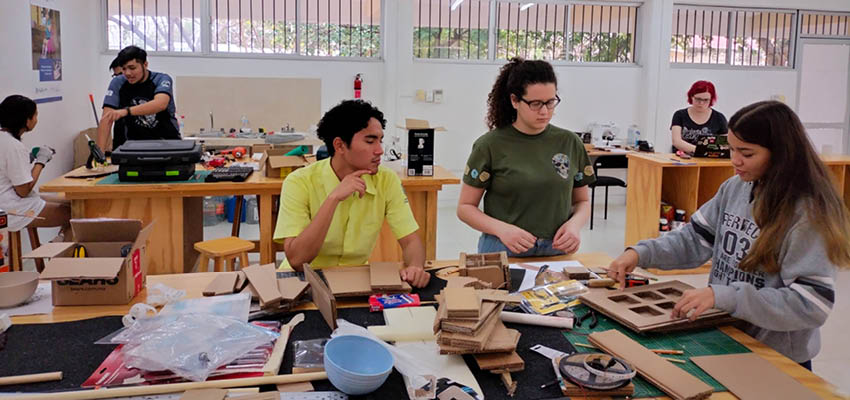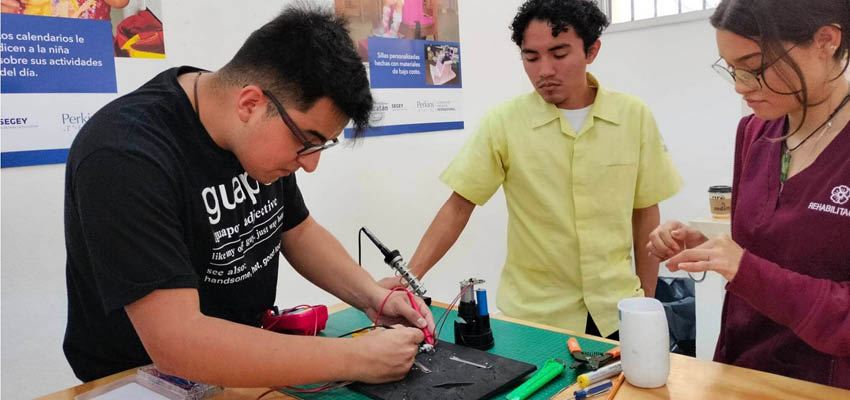
Read how MIT D-Lab students worked with Perkins staff and local partners on inclusive design projects in Yucatan, Mexico.
Original article on Perkins School for the Blind website
There are over 240 million children with disabilities around the world, and more than half cannot access an education. But through inclusive design, we can help more children and youth with disabilities learn.
At Perkins, including our international programs in 16 countries, we strive to close this gap and help more kids unlock opportunities— and we don’t do it alone.
Collaborating on inclusive design
In Mexico, we work closely with 27 public schools through our Model Program Approach. From teacher training and family workshops to state government partnerships, we know that to reach more children, there needs to be multilevel support. Since 2022, MIT D-Lab and Perkins have collaborated on innovative low-cost solutions for children with disabilities in Merida, Yucatan.
In January 2024, a new team of MIT students arrived with a project developed in partnership with the Adaptive Design Center (ADC) staff already in mind: how can we develop user-friendly electronic devices that can be easily reproduced by the local team in the ADC?
The team formed in the D-Lab’s introductory fall class, “D-Lab: Development,” and included Wellesley undergraduate Sofia Malika Djojonegoro and MIT undergraduates Helen Hu, Juan Antonio Luera, Dalila Valdes, and Sophie Zhang. After the winter holidays, Sofia Malika, Helen, Juan Antonio, and Dalila then traveled to Mexico for three weeks with Lecturer and Associate Director of Academics Libby Hsu, who built the initial relationship with Perkins.
About MIT D-Lab and the Adaptive Design Center
MIT D-Lab works with people around the world to develop and advance collaborative approaches and practical solutions to global poverty challenges. In collaboration with the Secretary of Education of Yucatan (SEGEY), Perkins supported the opening of an Adaptive Design Center (ADC) in Merida.
The ADC makes learning more accessible for students with disabilities by adapting equipment such as tables, chairs, and slant boards. In 2023, 45 students from special education schools in Yucatan benefited from customized designs produced by the ADC.
Inclusive design step 1: understanding the user
While in Merida, the four D-Lab students kept busy. Emelia Hernández Payán, Perkins’ Education Coordinator to Yucatan, helped the MIT students immerse themselves in the ADC workflow and introduced them to Yucatan’s special education school system.
The physical therapist and ADC supervisor Ernesto Palma, instructed the students on how to operate the tools in the workshop and oversaw their progress for four weeks. Ernesto provided guidance on the use of low-cost materials and imparted knowledge about disabilities and student characteristics.
During this time, the ADC also welcomed physical therapy and social work interns Ángel Manzanero and Paulina Narvaez, and physical therapy student, Horeb Garcia — all from the Autonomous University of Yucatan (UADY). The D-Lab students and UADY students collaborated on their respective goals, focused on understanding the needs of the user and where technology could best support them.

This year’s collaboration focused on constructing switch-based toys and appliance attachments powered by batteries.
The D-Lab students took existing switch-based solutions further by creating adaptations to household electronics like a blender. It required making small electric circuits in a PCB that could easily be connected to a blender and allow for connection to external buttons. To ensure the adapted devices were effective, the students needed to better understand the users’ needs.
So they visited two Perkins model public schools in Yucatan. One of them, CAM Tekax, is located deep in the countryside with a large Mayan population. By talking to educators, the students learned about the various needs of the pupils and their teachers at the school. Teachers at the other model school, CAM 5 Progreso, emphasized the need for using colors, sounds, and vibrations in their adapted devices to serve the needs of a large number of students with autism at that location.
After collecting the necessary research and feedback from the users, the MIT students and UADY interns were ready to move on to the next step: building prototypes.
Step 2: Building and testing the prototypes
After visiting the programs, the students were divided into two groups: Team Progreso and Team Tekax. Dalila, Helen, Paulina, and Ángel focused on a lighting box project in Progreso, while Juan Antonio, Sofia Malika, and Horeb focused on developing a switch for a blender in the Tekax project.
For kids like Manuel at the Tekax school, using a blender is not as simple as it seems. According to his classmates, Manuel plays a central role in the cooking class he takes as part of his vocational training. For example, he makes empanadas, a Latin American pastry filled with savory or sweet ingredients. Having a blender that is more easily activated by a large external button enables Manuel to fully participate in his vocational classes.
A girl seated in a wheelchair reaches for a green table where she finds an electronically powered tablet made out of cardboard. Around her, three adults observe her excitement upon seeing the lights on the board.
For Team Progreso, visiting the school allowed them to experience a normal school day for its students. On this visit, they noticed the widespread use of pictograms as a communication tool, which sparked their project idea. They decided to adapt this tool into an electronically powered tablet that lights up when the student presses the corresponding button.
Teachers can attach laminated pictures, words, or numbers to the buttons to run a particular lesson. The kids enjoyed the lights and were surprised by the colors and sounds made by the buttons, which the group hypothesized could help increase interactions and learning outcomes during lessons.
In addition to creating the devices and delivering them to each school, the D-Lab students created a bilingual instruction manual detailing how to build each adapted device. Since the ADC relies heavily on volunteers and interns, a manual will support others in building the same devices following clear and detailed instructions.
Step 3: Creating a lasting impact
These US students not only immersed themselves in the local culture during their time in Yucatan but also gained invaluable insights into the population’s distinctive needs. Concurrently, they honed their technical skills by engaging deeply with the concept of adapted design and how it can benefit those with disabilities.
The ADC estimates that the devices produced during the visit will benefit around 45 students at the Tekax and Progreso schools.
“We hope that the manuals written by the teams will lead to further iteration and innovation by ADC volunteers and teachers at the schools, as they tailor the basic designs to specific needs that arise in the future,” says Hsu.
“Over time, we want to contribute to the knowledge base at the ADC and share ideas with anyone who wants to use and build on them.”
Libby Hsu, Lecturer and Associate Director of Academy at MIT D-Labs

Beyond mere innovation, the goal between Perkins, UADY, and MIT D-Lab is to make a positive impact on the lives of children with disabilities. By fostering inclusivity through innovative solutions, we’re not just creating assistive equipment–we’re constructing bridges toward a more accessible and equitable future.
More information
MIT D-Lab class: D-Lab: Development
Contact
Libby Hsu, MIT D-Lab Associate Director of Academics

